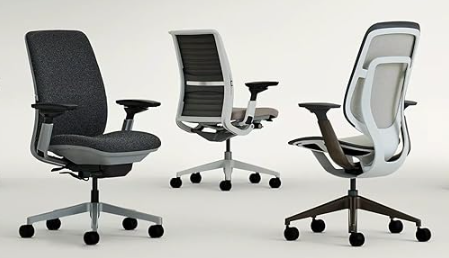
Discover how to choose the best ergonomic chair according to your body type. Learn which features matter most for comfort, back support, and better posture during long work hours.
Why You Need an Ergonomic Chair That Matches Your Body Type
Choosing the right ergonomic chair according to your body type is critical for long-term health and workplace productivity. Sitting for hours in an office chair that doesn’t support your frame can cause poor posture, spinal misalignment, and persistent back and neck pain.
Unlike one-size-fits-all seating, ergonomic seating solutions adapt to your body’s specific needs. Whether you’re tall, short, heavy, or slim, the right ergonomic chair will help you maintain proper alignment, improve blood circulation, and reduce fatigue throughout the day.
Essential Features of an Ergonomic Chair
To be truly ergonomic, a chair must support a natural sitting position while allowing movement and adjustment. Here are the key features to look for:
- Adjustable Seat Height: Your feet should rest flat on the floor, knees at 90°.
- Lumbar Support: Crucial for maintaining the spine’s natural curve and preventing lower back pain.
- Seat Depth & Width: Should accommodate your thighs without compressing the back of your knees.
- Adjustable Armrests: To support relaxed shoulders and proper elbow positioning.
- Backrest Tilt & Tension Control: Encourages micro-movements and posture changes.
How Your Body Type Influences Chair Selection
Everyone’s body is different. Choosing an office chair for back support that fits your specific body type ensures you’re not just sitting—you’re being supported.
1. For Taller Individuals
Look for:
- High-back chairs with extended head and neck support.
- Adjustable seat depth (ideally 19–21 inches) to support longer thighs.
- Adjustable lumbar height to match your lower back curve.
2. For Shorter Users
Look for:
- Lower seat height range (as low as 16 inches from the floor).
- Shallow seat depth (15–17 inches) to prevent cutting off circulation.
- Footrest if your feet don’t touch the ground.
3. For Heavier Body Types
Look for:
- A heavy-duty chair rated for higher weight (300+ lbs).
- Wider seat and backrest (minimum 22″ width recommended).
- Reinforced base and casters.
4. For Slim or Petite Builds
Look for:
- Chairs designed specifically for petite users or offering seat depth adjustment.
- Soft lumbar support with lower contour height.
- Smaller seat width and adjustable armrests.
Customizing Your Chair: Fine-Tuning for Comfort
Once you find the right chair for your body type, adjusting it properly is the next step.
Step-by-Step Setup:
- Seat Height: Adjust so feet are flat, thighs parallel to the floor.
- Seat Depth: Leave 2–3 inches between the seat edge and your knees.
- Backrest: Set to support the curve of your spine.
- Armrests: Align with elbow height to keep shoulders relaxed.
- Tilt Tension: Allow gentle recline for dynamic posture changes.
Signs Your Current Chair Doesn’t Fit
If you experience any of the following, your chair may not suit your body type:
- Feet not touching the ground
- Back pain or stiffness after work
- Pressure behind the knees
- Shoulder or neck tension
- Constant shifting or slouching
Recommended Ergonomic Chair Models (Based on Body Type)
| Body Type | Recommended Model | Key Feature |
|---|---|---|
| Tall | Steelcase Gesture | High back and seat depth adjustment |
| Short | Branch Ergonomic Chair | Low seat height and compact design |
| Heavy | HON Ignition 2.0 Big & Tall | Reinforced frame and wide seat |
| Petite | SIDIZ T80 | Adjustable everything, petite-friendly |
Final Thoughts: Your Health Deserves the Right Chair
Choosing the right ergonomic chair according to your body type is an investment in your comfort, posture, and long-term health. Whether you’re working from home or in an office, selecting a chair that matches your physical build ensures better back support, improved posture, and higher productivity.
Take the time to evaluate your body type, compare ergonomic features, and make adjustments that tailor the chair to you. Your spine, muscles, and focus will thank you.
FAQs: Ergonomic Chairs and Body Types
1. Can one ergonomic chair fit all body types?
No. While some chairs are highly adjustable, the best support comes from models designed with specific body types in mind.
2. What is the ideal seat depth for taller people?
Taller individuals typically need a seat depth of 19–21 inches to support their thighs comfortably.
3. Is lumbar support necessary for slim users?
Yes, but it should be subtle and adjustable to avoid overcorrecting their natural curve.
4. How do I know if a chair fits me properly?
Your feet should touch the floor, your knees should be at a 90° angle, and there should be no pressure behind the knees.
5. Can using the wrong chair cause health issues?
Absolutely. Poor support can lead to back pain, poor circulation, and long-term postural problems.
6. Should I consider a footrest if I’m short?
Yes. A footrest helps maintain proper leg positioning when the seat height is too tall, even at its lowest setting.














